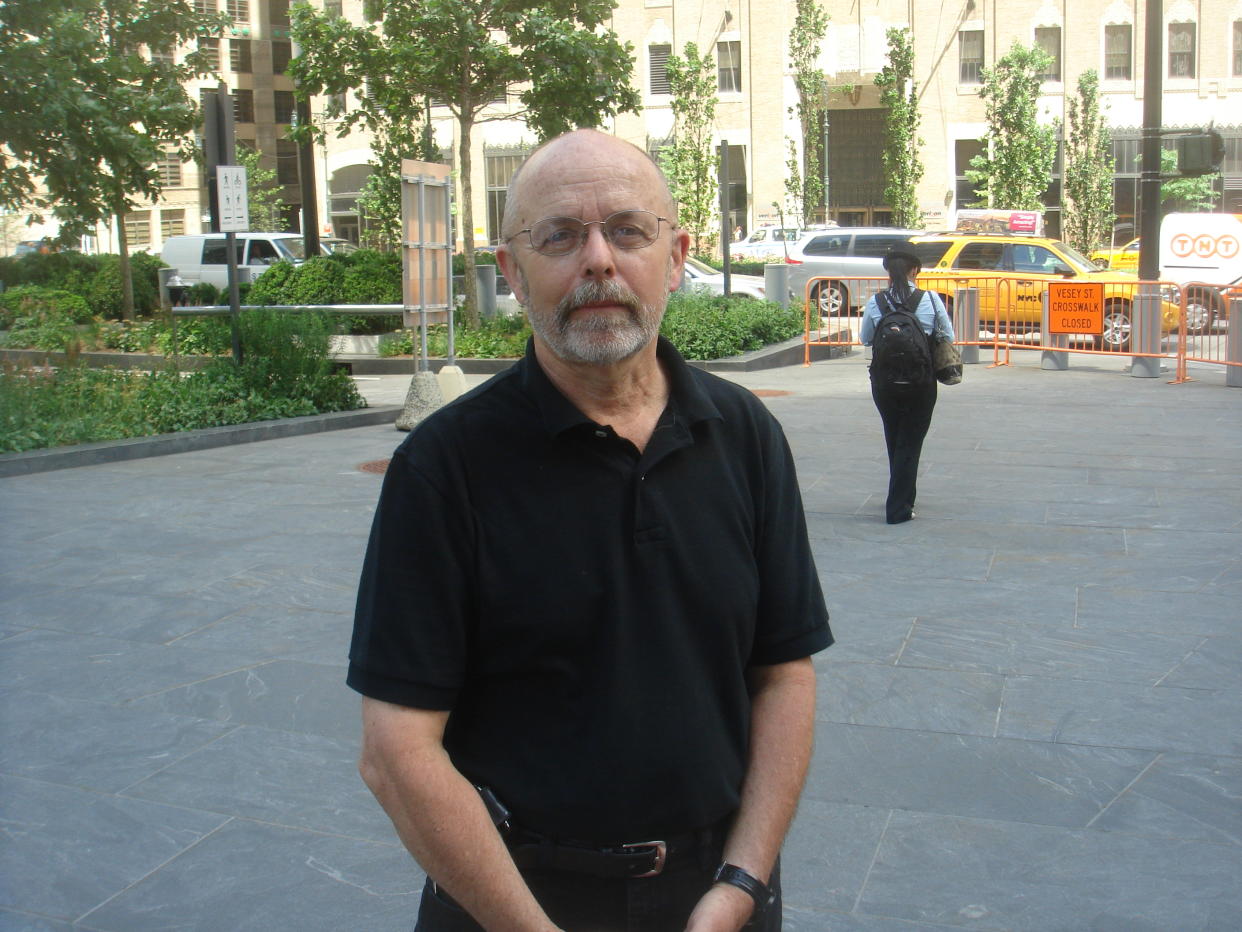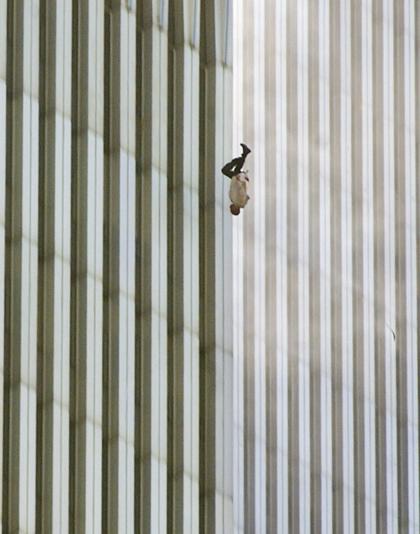 Yahoo 9/11 10th Anniversary
Yahoo 9/11 10th AnniversaryPhotographer behind 9/11 "Falling Man" retraces steps, recalls "unknown soldier"

Richard Drew put down his camera bag and looked up at the colossal skyscraper that seemed to be racing toward the clouds at an accelerated clip.
"I'm really surprised how fast this building's gone up," he said of the rising edifice at 1 World Trade Center, peering at the monolith from beneath the brim of a tan baseball cap. "I just hope it isn't another target."
It was around 2 p.m. on a bright Wednesday afternoon in mid-July, and Drew, a veteran Associated Press photographer with wire-rimmed glasses and a neatly cropped silver beard that betrays his 64 years, was standing near the northwest intersection of Vesey and West streets in Lower Manhattan, across from the noisy jungle gym of cranes and steel where a global business hub is currently being reconstructed. Nine years and eight months earlier in this very spot -- now an austere pedestrian plaza in the shadow of the Goldman Sachs building -- Drew took a picture that became one of the most iconic images of one of the most catastrophic events in American history.
[ Photo gallery: More of Richard Drew's photography from 9/11 ]
"I don't like coming down here," he admitted.
But he had nevertheless returned to retrace his steps for the first time since Sept. 11, 2001, when he had watched dozens die through the lens of a Nikon DCS620. On that similarly brilliant morning a decade ago, two planes had crashed into the Twin Towers by the time Drew emerged from the Chambers Street subway stop around a quarter after nine. The 110-story buildings looked like a pair of giant smokestacks spewing plumes of black soot into the crystal blue sky. He began shooting, focusing on the topmost floors. It wasn't long before he realized that some of the people trapped inside -- as many as 200 of them, it was later estimated -- had decided that plunging thousands of feet to their deaths was preferable to burning alive.
"There's one. There's another one," he said, recalling the horrific scene with a detached ease. "I just started photographing people as they were falling."
One of those people would come to be known as the Falling Man. Though his identity remains unconfirmed, some believe he was Jonathan Briley, a 43-year-old sound engineer who worked in a restaurant on the top floor of the North Tower. The man fell at 9:41, and Drew caught about a dozen frames of his fatal descent. In one of them, the subject soars earthward in a graceful vertical dive -- arms at his sides; left leg bent at the knee.
"Although he has not chosen his fate, he appears to have, in his last instants of life, embraced it," wrote Tom Junod in a renowned 2003 Esquire piece that coined the title of the photo, which won a 2001 World Press Photo award and is the subject of a 2006 documentary film. "If he were not falling, he might very well be flying."
Newspapers the world over made space for the Falling Man in their Sept. 12, 2001, editions. But the widespread publicity sparked a debate as to whether the image was too gratuitous for public consumption. "To me, it's a real quiet photograph," Drew argued. Unlike fellow AP photographer Nick Ut's Pulitzer-winning 1972 shot of a naked 9-year-old girl fleeing a napalm attack in Vietnam or Drew's famous photos of Bobby Kennedy's bloody dying breaths, "There's no violence in it," he said.
It was now close to 3 p.m., and Drew had decamped to a Shake Shack a few blocks from Ground Zero for a late lunch. Waiting for his food to arrive, Drew said he doesn't attend the memorial ceremonies held each year at the hallowed site nearby, nor does he plan to show up for the 10th anniversary of the tragedy. He was just doing his job that day.
"I don't need to be here to commemorate what happened to me," he said. "I record history every day. Everything I do, whether it's photographing DSK [Dominique Strauss-Kahn] in court, or the World Trade Center, or spring training baseball, it's all part of history, no matter how small or how large."
Drew likewise doesn't reminisce much about his experience on Sept. 11. (No lingering nightmares or PTSD, either.) He is reminded of the photo, however, twice a day, every day, through online news alerts that track mentions of the words "falling man" in the press. He picked up his BlackBerry to check the latest, in which "a 22-year-old man died Monday after falling off a rocky cliff and being swept out to sea in Hawaii," he reported. The alerts, which he created on his Yahoo! and Google accounts about eight years ago, rarely have anything to do with the actual Falling Man, but he likes to keep up anyway.
"I'm curious to see if people are writing about it or talking about it," he said. "To see how they might interpret the picture."
[ Photos: Images of the 9/11 Memorial at Ground Zero ]
Sometimes the Falling Man reveals himself where it's least expected. Drew's longtime neighbor, the author Helen Schulman, lives five floors above the apartment Drew shares with his wife, his two daughters, and the family's 5-year-old golden retriever, Ajax, in a prewar building on the Upper West Side. Schulman wrote an entire novel without knowing that Drew, as she explains in the acknowledgements, had taken the "picture that haunted and inspired me throughout the years of writing" it. Drew and Schulman serendipitously connected the dots after she completed the first draft of the book, "A Day at the Beach" -- about a distraught family that flees Manhattan for the Hamptons on Sept. 11 -- which was published in 2007.
"It's always going to be a part of me," perhaps more than any other photo he's ever taken, Drew said.
But has it changed him?
He put down the last bite of his Chicago dog, took a sip of beer, and dabbed his mouth with a napkin before pausing to contemplate.
"I think of it as a learning experience," he said of the photo and Sept. 11 in general. "I get so caught up in the adrenaline of doing this job. So, looking back on it, I think a lot about being able to go home to my family every night. Whether I decide to think about it daily or not, it's always in the back of my mind. It's this world event that I have become a part of in my own little tangential way. I'm not a hero fireman; I didn't die there; I didn't have a loved one who passed away there. But it's something I'll never forget."
As for the anonymous soul whose legacy Drew has unwittingly preserved, "Even if people don't want to see my photograph, that man did fall out of the building," he said. "To me, he'll always remain the unknown soldier."
Share your 9/11 memories with us on Twitter - #911remembered



